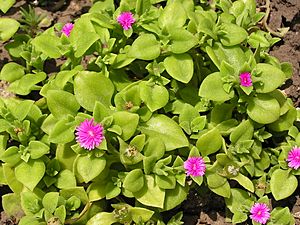Mesembryanthemum cordifolium facts for kids
Quick facts for kids Mesembryanthemum cordifolium |
|
|---|---|
 |
|
| Scientific classification | |
| Synonyms | |
Mesembryanthemum cordifolium, once known as Aptenia cordifolia, is a type of succulent plant. It belongs to the iceplant family. This plant grows along the ground like a creeping plant. It forms a soft carpet of green leaves. The name Mesembryanthemum means "middle-embryo flower." This refers to where the ovary is located in the flower. Its specific name, cordifolium, comes from Latin. It means "heart-shaped leaves."
Contents
What the Plant Looks Like
This plant is a succulent that grows close to the ground. It forms flat clumps from a woody base. The plant usually grows about 10 centimetres (3.9 in) tall. But its stems can spread out up to 60 centimetres (24 in) long. The stems are green and round.
Its leaves are small and fleshy. They are shaped like hearts or ovals. Each leaf is about 2.5 centimetres (0.98 in) long. They have tiny bumps called papillae on them. Bright pink or purple flowers grow where the leaves meet the stem. These flowers open during the day. They close at night or on cloudy days. The colorful parts you see are not true petals. They are modified stamens. The real stamens are yellow. The plant blooms mostly from spring to fall. Its fruit is a small capsule. Inside are tiny brown seeds. There is also a type of this plant with variegated (mixed color) leaves.
Different Names for the Plant
This plant has many common names. In English, people call it baby sun rose, heart-leaf, red aptenia, or just aptenia. In Afrikaans, it's known as rooi brakvygie or brakvygie. In isiZulu in South Africa, it might be called umjuluka, ibohlololo, or uncolozi omncane. In the USA, it's called heartleaf iceplant. British names include heart-leaved aptenia or heart-leaved midday flower. This is because its flowers, like many iceplants, only open when the sun is shining.
How Scientists Classify It
Mesembryanthemum cordifolium is the accepted scientific name. It was once part of a different group called Aptenia. So, it used to be known as Aptenia cordifolia. But in 2007, scientists moved all Aptenia plants into the Mesembryanthemum group.
You might see a plant called Mesembryanthemum 'Red Apple in gardens. This is a hybrid plant. It's a mix of M. cordifolium and M. haeckelianum. The 'Red Apple' grows faster. It has red flowers and bright green leaves. The true M. cordifolium species has magenta-purple flowers. Its leaves are more heart-shaped and have a textured feel.
Where the Plant Grows
This plant first came from the Eastern Cape Province of South Africa. It became very popular as an ornamental plant for gardens. Today, you can find it growing in Australia. It has also escaped from gardens and grows wild in parts of California, Oregon, and Florida. It's also found in the Mediterranean parts of Europe and central Mexico. In California, it is now considered an invasive species. This means it can spread quickly and harm local plants.
Uses of the Plant
The main use for Mesembryanthemum cordifolium is as a garden plant. People grow it because it looks pretty. In its native region, some local people have used the plant for its anti-inflammatory properties. This means it might help reduce swelling or pain.
How to Grow This Plant
Mesembryanthemum cordifolium grows quickly. It can be planted as a groundcover in flower boxes or around traffic lights. It needs a sunny spot to grow well. The soil should drain water easily. This plant is also great for covering walls, rock gardens, or bare areas. Because it grows fast, it can help stop weeds from growing. You can also grow it in a pot. It looks nice in hanging baskets, where its long branches can trail down. In cold places, you need to keep it indoors during winter. It should be in a sunny spot where the temperature is about 5 to 8 °C (41 to 46 °F). This plant usually doesn't have many problems with insects or diseases.
Plant Reproduction
This plant is easy to grow from cuttings. You can take pieces of its stems or even its leaves. It also grows from seeds found in its fruit. If you take cuttings, you can plant them directly into the ground. The soil should be prepared by digging it up. Adding Compost and a slow-release fertilizer helps it grow strong. The plant is very good at handling drought (dry weather). But it grows best with moist soil. It's important that the soil drains well. This plant cannot handle frost. It will freeze if the temperature drops below −5 °C (23 °F).
Gallery
See also
 In Spanish: Rocío para niños
In Spanish: Rocío para niños



